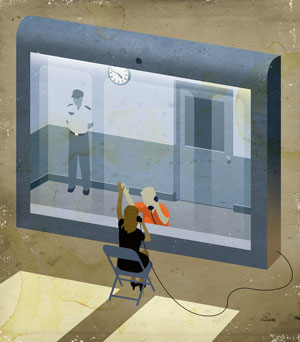Another jail eliminates in-person visits and adopts 50-cent-a-minute video visitation

Illustration by Sam Ward.
Jails are increasingly offering video visitations for inmates, and some facilities are citing the new, sometimes pricey service as a reason to restrict or ban in-person visitations.
The Northwest Arkansas Democrat reports on the upcoming launch of a remote video visitation system in Benton County, Arkansas, that will cost 50 cents a minute in 15-minute increments. The jail will no longer allow in-person visits, the only free way to visit inmates for those who are not attorneys.
People who want to visit the inmates can use their home computer to access smartjailmail.com.
A spokesperson for the sheriff’s office told the Democrat that eliminating in-person visits will decrease contraband and free up employees who had to monitor such visits. It will also be easier for friends and family members who had to travel long distances to visit inmates.
Video visitation is increasing in popularity, and jails often get “a hefty percentage” of the fees, Ars Technica reported in May. The Guardian also noted the trend, as did the Los Angeles Times in an editorial last year against elimination of in-person visitation.
Lucius Couloute, an expert at the Prison Policy Initiative, told Ars Technica and the Guardian that an estimated 600-plus correctional facilities across the country have implemented some form of video calling. About three-quarters of the jails that implement the technology “end up eliminating or scaling back in-person visits,” Couloute, told Ars Technica.
The fees paid to jails provide an incentive to restrict in-person visiting, prisoner-rights advocate Alex Friedmann told Ars Technica. The price for the service is sometimes as high as a dollar a minute, Friedmann said. Typical commissions paid to jails are in the 20 to 25 percent range, he said.
The American Correctional Association said in a 2016 policy statement that emerging technologies should be used as supplements to in-person visitation, and they should not create an unreasonable financial burden on inmates and their families and friends.
The ABA Criminal Justice Section’s Standards on the Treatment of Prisoners, adopted by the House of Delegates in 2010, also warn about eliminating in-person visitation. According to Standard 23-8.5, prisoners confined more than 30 days should generally be allowed contact visits. Corrections officials should promote communication between prisoners and their families, including video visitation, “provided that such options are not a replacement for in-person contact,” the standard says.
The Guardian asks whether in-person visitation is a legal right. The U.S. Supreme Court has not considered the question, although the court ruled in 2003 that visitation restrictions with a rational relation to prison management don’t violate a constitutional right of association, according to the Guardian.
See also:
ABA Journal: “Appeals court stymies bid to regulate high cost of prison phone calls”
ABA Journal: “Is video visitation helpful or harmful for prisoners and their families?”
Write a letter to the editor, share a story tip or update, or report an error.


